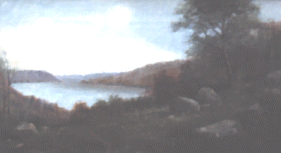|
|
|


Alfred Bierstadt in the London Saturday Review, 1868 stated,
"A critical account of 'Storm in the Rocky Mountains' he is always trying for luminous graduation and useful oppositions and he reaches what he tries for."
This reference to luminous graduation is a key to Bierstadt's and Snyder's (his pupil) success at dealing with the representation of light. How they developed such sensitivity to tone and its modulation is difficult to know. In any event, their control of tonality, particularly in the subtle graduation of luminous backgrounds, can be visually breathtaking. The way he invariably leads your eye back though his Beechwood scenes, maybe down a road or path to a rail fence with a clearing and meadow beyond to a small house or barn, is just delightful. One such picture cleaned and restored by me contained 12 white turkeys so miniature that I had to take a magnifying glass to discern different stances, with single hair-sized yellow legs extending into the grass. It was almost unbelievable. The owner of the picture had never seen them before!
I'm sure that Mr. Bierstadt helped inspire Snyder to attempt his larger canvases, also in the use of photography, to aid in doing large studio production canvases too large to handle on location in the open. I'm sure he preferred working in "plein air". One friend, Mr. Spaulding, a photographer, often accompanied him on sketching trips. According to Mrs. Lottie Spaulding, a daughter-in-law, her father-in-law would take pictures while Snyder would rough in a picture on location in order to get the feel of the day, light, sky cloud color and formation, color intensity, etc. He would then use the photograph to fill in all of the minute detail that he did so well and for which he is so famous. Spaulding was also a friend. patron and benefactor, buying unframed canvases when Snyder was in urgent need of money.
The influence of another great teacher, Mr. George Innes, Sr. in broad panorama, can be seen in the compositional layout of some of Snyder's work. Also, according to his son, Mr. Innes painted very rapidly. It has also been said of Mr. Snyder that he could go out in the morning and return with a finished picture in the evening, yet I have never seen a hurried, unfinished or less-than-perfect Snyder painting.
From Alexander Wyant, Snyder learned to paint trees, trunk roots and foliage with strict adherence to the character of the genus. Fallen trees in various states of decay are so well done and usually placed in the foreground where so much detail and color variation is necessary. Some of the old logs look so punky you feel you could reach out and pluck a handful of the rotten wood. Rock, whether ledges at Clifty Falls, Little Cedar Cliff or Hanging Rock, or boulders and small stones along a creek bed, are so perfectly done with highlights and shadows in exactly the right places, regardless of size or shape, there is never a contrived placement.
Tribute to a Madison artist W. McKendree Snyder whose work is recognized all over the country. As true to Nature and wonderfully pleasing - A student under Best Masters.
Although not a resident of Cincinnati at the present time, there are few artists whose pictures are better known to local patrons of art than those of W. McKendree Snyder, the painter of beech-tree forests.
Mr. Snyder's home is in Madison, Ind., but he is known personally to many of the artists of the city, where his pictures have become general favorites. He was born more than sixty years ago in Liberty, Ind. and was the son of a Methodist minister. His artistic instinct was developed early, and after serving in the Civil War as a drummer boy, enlisting at the age of 12, he entered upon his art career. Mr. Snyder's first work was done with J. Insaco Williams who at that time had a studio in this city at the corner of Fourth and Elm Streets. After working at portrait painting for several years, he went to New York, where he studied with Bierstadt. Several years after he continued his education with Hunt of Boston and later with A. H. Wyant and Hart.
Before abandoning the figure and portrait work, he painted "Pythias at the Block", a large canvas which was destroyed by fire in Indianapolis and also the "Battle of Shiloh", 9 ft. x 20 ft., which is now owned by Kohl and Middleton of Chicago. He also has work hanging in the Boston Athenaeum and in the Treasury Department at Washington. For several years. he gave his attention to painting the nude, and one of the best known examples of that period is "The Nymph of the Lilies" which hung for some time in the Gibson House.
Finally, Mr. Snyder discarded all but landscapes and made a specialty of Beeches. because he was more interested in the work. He is located in the midst of Beech country on the continent, and makes daily trips to the woods.
Mr. Snyder is a realist, and a careful attention to detail is one of his most notable characteristics, as it is of so many older artists. Each leaf in his picture of the forest is as carefully done as the trunk of the tree. He is always highly complimented on his perspective and his rich autumn colorings are fine. His work is always true to nature and is wonderfully pleasing.
Mr. Snyder did a large painting of a girl on a couch in a semi nude state. Behind her knees was a cut glass decanter with red wine on a pedestal in front of a three panel screen. At the top of the screen was a panel of battleship Grey paint. On close examination where the gray approached a red velvet drapery another color could be seen so I started to remove the gray at gray at 7:00 P.M. by 1:00 P.M. I had uncovered a young man whose fingers were clinching the top of the screen and he was peering over at the recumbent young lady, and he looked scared. There had been a blue glass vase with pink & white carnations painted over the decanter. This was after prohibition closed the saloon, and the painting had gone into private hands.
Mr. Snyder ran a liquor bill at Doodle Coyle's Saloon an Mr. Coyle offered to let him work it out on a painting for over the back bill. Mr. Coyle was presented a bill and he remonstrated that he thought he was letting Mr. Snyder work out his bill, but Snyder said his painting was more valuable. Finally Mr. Snyder took the matter to court, appraisers were brought down from Cincinnati and the saloonkeeper had to pay the difference of Mr. Snyder's bill.

| Intro page | Snyder 1 | Snyder 2 | Snyder 3 | Snyder 4 | Snyder 5 | ||||||||||||||||||||||||
| Snyder 6 | Snyder 7 | Praying Hands | Ask the Photographer | Don's Computer site |
 Don Wood Don Wood |
Created June 30, 1998 and modified on 6/15/03 using Homesite 4 HTML editor Link to Homesite web site |
page designed by Don Wood